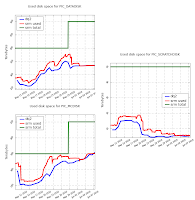 Last month it was ATLAS who was checking the consistency of their catalogs and the actual contents in our Storage. The ultimate goal is to get rid of what has been called as "dark" or uncatalogued data, which fills up the disks with unusable data. Let us recall that at that time ATLAS found that 10% of their data at PIC was dark...
Last month it was ATLAS who was checking the consistency of their catalogs and the actual contents in our Storage. The ultimate goal is to get rid of what has been called as "dark" or uncatalogued data, which fills up the disks with unusable data. Let us recall that at that time ATLAS found that 10% of their data at PIC was dark...Now it has been CMS that has carried out this consistency check on the Storage at PIC. Fortunately, they have also quite automatized machinery for this so we have got the results pretty fast.
Out of almost 1PB they have at PIC, CMS has found a mere 15TB of "dark data", or files that were not present in their catalog. Most of them from pretty recent (Jan 2010) productions that were known to have failed.
So, for the moment the CMS data seems to be around one order of magnitude "brighter" than the ATLAS one... another significant difference for a two quite similar detectors.





